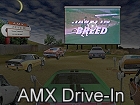Site Tools & Extras
Quick Links
American Motors eXperimental
AMX American Motors' Two-Seater

From CAR LIFE - March, 1968
Here comes image buster No. 2 --- and it fits neatly between the Ponycars and the sports cars.
THE NEW CARS, AND DRIVING THEM - American Motors has finally sprung its two-seat AMX and Engineering Editor Jon McKibben had a chance to run it at familiar Orange County Raceway. And when Jon sprinted against a well-known race driver around the road course, it was the race driver who ate dust.
THE AMX IS THE SECOND image buster in American Motors' ever-increasing brood of excitement machines. Whatever the outcome of AMX's sales campaign, the slick new two-seater is graphic proof of a new era at American Motors. The end of stale, stuffy, practicality-pushing management at AMC is here. We applaud the newcomer.

The AMX is not a really advanced sports car, in spite of its two-passenger capacity. Neither is it a sophisticated GT vehicle of the Corvette-Jaguar XKE variety. It is, however, a two-seater that fits neatly into the gap between domestic Ponycars and imported high-performance sports cars. More fun, and less practical than a four-passenger Ponycar, the AMX may represent the next popular phase in America's changeable car-buying trends.
No one is claiming that the AMX is an all-new car. Obviously, it's not. The AMX chassis is almost entirely Javelin, with the exception of the new 390-cid/ 315-bhp engine. This new, larger powerplant will be offered as a Javelin option following AMX introduction, so even this distinction between Javelin and AMX is short-lived. Looking through the specifications, the only item significantly different is the AMX's 97in. wheelbase compared to the Javelin's 109 in. And, looking at the exterior of the AMX, it is obvious that this 12-in. shortening was done by removing a section just aft of the door B-pillar.
The majority of body pieces are interchangeable between Javelin and AMX. The hood panel of the AMX sports triangular-section bulges in place of the Javelin's twin recesses but the change could be made by simply restriking hood panels with the same basic tooling. From the rear edge of the doors forward, no real differences exist. From this line rearward, the body shape emphasizes the short deck, sloping backlight theme currently in vogue for sporting machinery.
No changes have been made in the suspension, steering or brake systems, except for the inclusion, as standard equipment, of a pair of trailing arms to locate the rear axle against power hop. These arms are available as a dealer installed option on the Javelin.
The AMX will not be made available with anything less than the 290-cid V-8 engine with four-barrel carburetor. This is in keeping with the image-busting character of the car. Frankly, we'd like to see the car offered with a 6-cyl. engine, and given a low list price. But, American Motors probably is wise in its approach. Many features that are extra-cost options on the Javelin have been made standard on the AMX. The 343-cid and 390-cid engines are available, and afford the AMX a performance level which, while a little under the Supercar bracket, is certainly ample for any reasonable highway use. Quarter-mile racing fans undoubtedly will find ways to improve upon the AMX's mid-14 sec. acceleration time, although such a figure is very respectable.
The only transmissions for the AMX will be the standard, close-ratio fourspeed manual gearbox or an optional three-speed automatic unit. Rear axle ratios run from 2.87:1 up to 3.54:1. Dealer-installed axle ratios include 4.10:1 and 4.44:1, strictly for drag racing. Standard suspension system has ride rates of 120/131 lb./in., front/rear. Optional ride rates of 136/148 lb./in., front/rear, provide firmer handling for really spirited motoring. The resultant handling is of the vintage sports car variety-stable but stiff, and most applicable to hard cornering on very smooth surfaces.
American Motors' executives are emphatic about the relationship of the AMX to Chevrolet's Corvette. They state that the AMX is not, repeat not, in direct competition with the admittedly more sophisticated, higher performance Corvette. But, they are quick to point out that the AMX is priced about $1500-$2000 less than a comparably equipped Corvette. We'll let readers weigh the merits of these two, the only American two-seaters. The comparison is sure to be made, and relative values can easily be assessed.

In straight-line acceleration, the AMX is superior to the Javelin, simply because of slightly less vehicle weight. With the 390-cid engine, quarter-mile times of 14.7 sec. can be obtained, with trap speeds around 95 mph. This is completely stock, with standard equipment fiberglass-belted E70-14 tires. With drag racing tires, high rear axle ratio and open exhaust, 13-sec. elapsed times should easily be obtainable. Top speed, with 3.15:1 axle ratio, is in the 130-mph range. And, this top speed is attainable in a short distance (less than a mile on the car we drove).

Handling was good on the smooth test track we used. When pushed really hard, understeer was the dominant characteristic. Probably because of the shorter wheelbase, however, agility was definitely superior to the Javelin. The lower polar moment of inertia of the AMX accentuated its sporty, responsive nature. Also, understeer was much less obvious than it was in the Javelin. Shortening the wheelbase gave better weight distribution, apparently reduced basic understeer without significant suspension geometry changes. Smooth road handling was very predictable, close enough to neutral to be fun, and comparable to many imported sports cars. We really didn't have an opportunity to evaluate ride quality. AMC engineers did state, though, that ride quality had been considered subordinate to handling precision in formulating AMX suspension components.
It seems reasonable, viewing the AMX specifications list, to expect acceptable smooth-road ride quality, but rough surfaces undoubtedly will cause rearaxle skittering and general ride harshness. Again, however, ride quality will probably be superior to many imports of less performance and equivalent handling.
What is the AMX? It's a car to show the world that American Motors is in the high-performance market. That the car performs as well as it does is tribute to the engineering crew that formulated it. Some of the old-timers are still a bit uneasy in this field. One of the top American Motors engineers, upon seeing the smoke pouring off the front disc brakes of CAR LIFE'S test vehicle (after several really hot laps around a road course), looked horrified and mumbled something like "these cars aren't intended for this kind of driving."
The AMX is not only intended for this kind of driving, it is a great tool for it. American Motors' ultra-conservative approach to automotive design should provide the enthusiast with a superbly reliable vehicle, one that holds strength in reserve during the most vigorous motoring.
The AMX is a fun car, a logical extension of the Ponycar scheme. The two-passenger capacity rules out the AMX as family transportation, but a couple will find the car a ball to drive. As a single-occupant commuting tool, the AMX adds a large measure of driving pleasure to an uninspiring task. For zipping through the countryside, over winding roads with sparse traffic, the AMX delivers the kind of enjoyment previously reserved for the very rich or the very Spartan.






